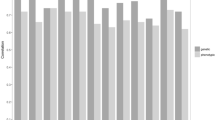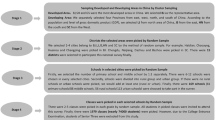Abstract
This work reports on a study to evaluate the relative contributions of genetic and environmental factors to both competence scales and behavioral/emotional syndromes as assessed by the Child Behavior Checklist (CBCL). A total of 279 pairs of twins and same-sex sib-pairs aged 12–16 years were recruited from 51 junior high schools in Taipei City, Taiwan. Twins' zygosity was determined by a combination of DNA typing and physical similarity. The Mx program was used to estimate parameters for a full model that contains effects from sex-specific additive genes, shared environment, and nonshared environment for the majority of the scales. The shared environment in the full model was replaced with nonadditive genetic factors for some scales when indicated. All girls' competence and behavioral/emotional syndromes exhibited a substantial heritability (h2 > 0.4), except for Social Competence and Withdrawn. For boys, though the heritability was also >0.4 for some scales (Social and School Competence, Thought Problems, Attention Problems, Delinquent Behavior, and Total Behavior Problems), environmental influences, especially shared environment, were predominant for most of the scales (10 out of 15 scales). Genetic factors are important for explaining adolescent behavioral problems, especially for girls, while shared environmental influences cannot be ignored for boys. Gender differences in heritability exist for various CBCL-based competence and behavioral/emotional problems.
Similar content being viewed by others
References
Achenbach, T. M. (1991). Manual for the Child Behavior Checklist/4-18 and 1991 Profile. Burlington, VT: Department of Psychiatry, University of Vermont.
Beunen, G., and Thomis, M. (1999). Genetic determinants of sports participation and daily physical activity. Int. J. Obes. Related. Metabol. Disord. 23:S55-S63.
Biederman, J., Wozniak, J., Kiely, K., et al. (1995). CBCL clinical scales discriminate prepubertal children with structured interview-derived diagnosis of mania from those with ADHD. J. Am. Acad. Child Adolesc. Psychiatry. 34:464-471.
Chen, C. J., Lin, T. M., Chang, C., et al. (1987). Epidemiological characteristics of twinning rates in Taiwan. Acta Genet. Med. Gemellol 36:335-342.
Chen, W. J., Chang, H.-W., Wu, M.-Z., et al. (1999). Diagnosis of zygosity by questionnaire and polymarker polymerase chain reaction in young twins. Behav. Genet. 29:115-123.
Chen, W. J., Faraone, S. V., Biederman, J., et al. (1994). Diagnostic accuracy of the Child Behavior Checklist scales for attentiondeficit hyperactivity disorder: A receiver-operating characteristic analysis. J. Consul. Clin. Psychol. 62:1017-1025.
Eaves, L. J., Silberg, J. L., Meyer, J. M., et al. (1997). Genetics and developmental psychopathology. II. The main effects of genes and environment on behavioral problems in the Virginia Twin Study of Adolescent Behavioral Development. J. Child Psychol. Psychiatry 38:965-980.
Edelbrock, C., and Costello, A. J. (1988). Convergence between statistically derived behavior problem syndromes and child psychiatric diagnoses. J. Abnorm. Child Psychol. 16:219-231.
Edelbrock, C., Rende, R., Plomin, R., et al. (1995). A twin study of competence and problem behavior in childhood and early adolescence. J. Child Psychol. Psychiatry 36:775-785.
Eley, T. C., Lichtenstein, P., and Stevenson, J. (1999). Sex differences in the etiology of aggressive and nonaggressive antisocial behavior: Results form two twin studies. Child Develop. 70:155-168.
Gjone, H., Stevenson, J., and Sundet, J. M. (1996). Genetic influence on parent-reported attention-related problems in a Norwegian general population twin sample. J. Am. Acad. Child Adolesc. Psychiatry 35:588-596.
Hewitt, J. K., Silberg, J. L., Neale, M. C., et al. (1992). The analysis of parental ratings of children's behavior using LISREL. Behav. Genet. 22:293-317.
Huang, H. L., Chuang, S. F., Wang, Y. C., Chen, Y. C., Tseng, C. C., Yu, L. H., Chiu, Y. N., Wu, Y. C., and Chen, Y. S. (1994). Developing the multiaxial behavioral assessment of children in Taiwan. In Chinese Assessment Association (eds.), Psychological Assessment in Chinese-Speaking Society. (pp. 259-310). Taipei, Taiwan, Psychol Press [in Chinese].
Hudziak, J. J., Rudiger, L. P., Neale, M. C., et al. (2000). A twin study of inattentive, aggressive, and anxious/depressed behaviors. J. Am. Acad. Child Adolesc. Psychiatry 39:469-476.
Lin, C. C. H. (1999). A Twin Study on Schizotypy and Sustained Attention Among Adolescents. Ph.D. dissertation, National Taiwan University [in Chinese with English abstract].
Martin, N., Boomsma, D., and Machin, G. (1997). A twin-pronged attack on complex traits. Nat. Genet. 17:387-392.
McGue, M., Bouchard, T. J. Jr., Iacono, W. G., et al. (1993). Behavioral genetics of cognitive ability: A life-span perspective. In Plomin, R. and McClearn, G. E. (eds.), Nature, Nurture, and Psychology (pp. 59-76). Washington, D.C.: American Psychological Association.
McGuire, S., Manke, B., Saudino, K. J., et al. (1999). Perceived competence and self-worth during adolescence: A longitudinal behavioral genetic study. Child Develop. 70:1283-1296.
McGuire, S., Neiderhiser, J. M., Reiss, D., et al. (1994). Genetic and environmental influences on perceptions of self-worth and competence in adolescence: A study of twins, full siblings, and stepsiblings. Child Develop. 65:785-799.
Miles, D. R., van den Bree, M. B., and Pickens, R. W. (2002). Sex differences in shared genetic and environmental influences between conduct disorder symptoms and marijuana use in adolescents. Am. J. Med. Genet. 114:159-168.
Nadder, T. S., Silberg, J. L., Eaves, L. J., Maes, H. H., and Meyer, J. M. (1998). Genetic effects on ADHD symptomatology in 7-to 13-year-old twins: Results from a telephone survey. Behav. Genet. 28:83-99.
Neale, M. C. (1997). Mx: Statistical Modeling (4th ed.). Genetics and Human Development Tech. Rep., Richmond, VA: Department of Psychiatry, Medical College of Virginia, Virginia Commonwealth University.
Neale, M. C., and Cardon, L. R. (1992). Methodology for Genetic Studies of Twins and Families. New York: Kluwer Academic.
Neale, M. C., and Miller, M. B. (1997). The use of likelihood-based confidence intervals in genetic models. Behav. Genet. 27:113-119.
Rice, F., Harold, G. T., and Thapar, A. (2002). Assessing the effects of age, sex and shared environment on the genetic etiology of depression in childhood and adolescence. J. Child Psychol. Psychiatry 43:1039-1051.
Rowe, D. C., Jacobson, K. C., and van den Oord, E. J. C. G. (1999). Genetic and environmental influences on vocabulary IQ: Parental education level as moderator. Child Dev. 70:1151-1162.
Rutter, M., and Rutter, M. (1993). Developing Minds: Challenge and Continuity Across the Life Span. London: Basic Books.
Rutter, M., Silberg, J., O'Connor, T., et al. (1999). Genetics and child psychiatry. I. Advances in quantitative and molecular genetics. J. Child Psychol. Psychiatry 40:3-18.
SAS Institute Inc. (1997). SAS/STAT Software: Changes and Enhancement through 6.12. Cary, NC: SAS Institute.
Schmitz, S., Cherny, S. S., Fulker, D. W., et al. (1994). Genetic and environmental influences on early childhood behavior. Behav. Genet. 24:25-34.
Schmitz, S., Fulker, D. W., and Mrazek, D. A. (1995). Problem behavior in early and middle childhood: An initial behavior genetic analysis. J. Child Psychol. Psychiatry 36:1443-1458.
Silberg, J. L., Erickson, M. T., Meyer, J. M., et al. (1994). The application of structural equation modeling to maternal ratings of twins' behavioral and emotional problems. J. Consul. Clin. Psychol. 62:510-521.
Silberg, J., Pickles, A., and Rutter, M. (1999). The influence of genetic factors and life stress on depression among adolescent girls. Arch. Gen. Psychiatry 56:225-232.
Simonoff, E., Pickles, A., Hervas, A., et al. (1998). Genetic influences on childhood hyperactivity: Contrast effects imply parental rating bias, not sibling interaction. Psychol. Med. 28:825-837.
Slutske, W. S., Heath, A. C., Dinwiddie, S. H., et al. (1997). Modeling genetic and environmental influences in the etiology of conduct disorder: A study of 2,682 adult twin pairs. J. Abnorm. Psychol. 106:266-279.
Sourander, A., Helstela, L., and Helenius, H. (1999). Parentadolescent agreement on emotional and behavioral problems. Soc. Psychiatry Psychiatr. Epidemiol. 34:657-663.
Thompson, L. A., Detterman, D. K., and Plomin, R. (1993). Differences in heritability across groups differing in ability, revisited. Behav. Genet. 23:331-336.
van den Oord, E. J., Verhulst, F. C., and Boomsma, D. I. (1996). A genetic study of maternal and paternal ratings of problem behaviors in 3-year-old twins. J. Abnorm. Psychol. 105: 349-357.
van der Valk, J. C., Verhulst, F. C., Stroet, T. M., et al. (1998). Quantitative genetic analysis of internalizing and externalizing problems in a large sample of 3-year-old twins. Twin Res. 1:25-33.
Viken, R. J., Kaprio, J., Koskenvuo, M., et al. (1999). Longitudinal analysis of the determinants of drinking and of drinking to intoxication in adolescent twins. Behav. Genet. 29:455-461.
Yang, H. I., Soong, W. T., Chiang, C. N., et al. (2000). Competence and behavioral/emotional problems among Taiwanese adolescents as reported by parents and teachers. J. Am. Acad. Child Adolesc. Psychiatry 39:232-239.
Yang, H. J., Chen, W. J., and Soong, W. T. (2001). Rates and patterns of comorbidity of adolescent behavioral syndromes as reported by parents and teachers in a Taiwanese non-referred sample. J. Am. Acad. Child Adolesc. Psychiatry 40:1045-1052.
Author information
Authors and Affiliations
Rights and permissions
About this article
Cite this article
Kuo, PH., Lin, C.C.H., Yang, HJ. et al. A Twin Study of Competence and Behavioral/Emotional Problems Among Adolescents in Taiwan. Behav Genet 34, 63–74 (2004). https://doi.org/10.1023/B:BEGE.0000009477.70657.9d
Issue Date:
DOI: https://doi.org/10.1023/B:BEGE.0000009477.70657.9d




